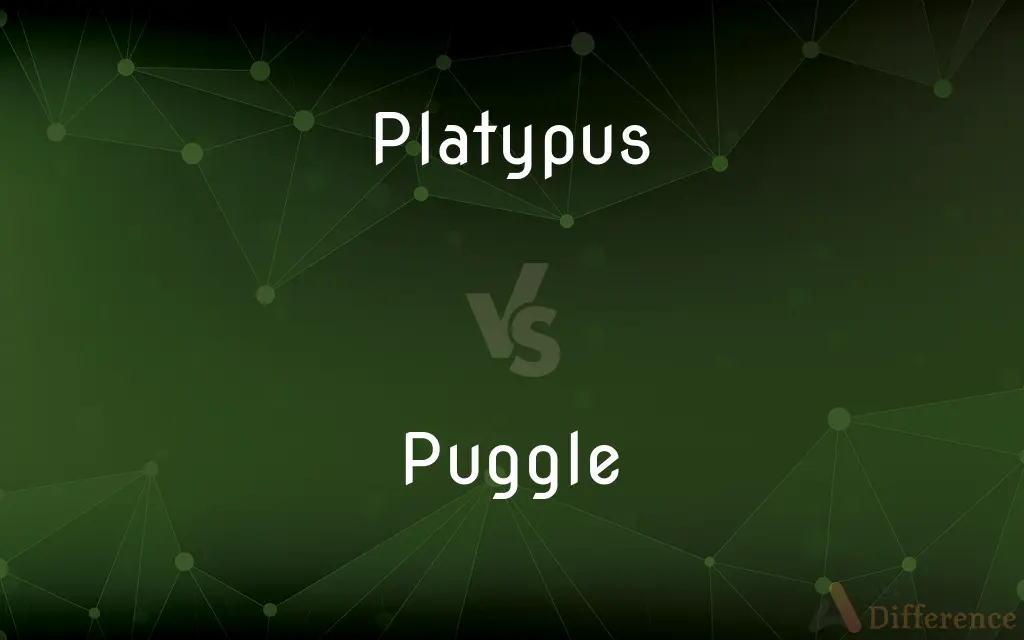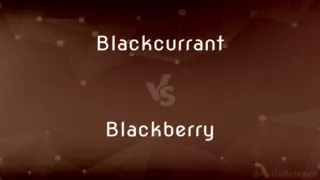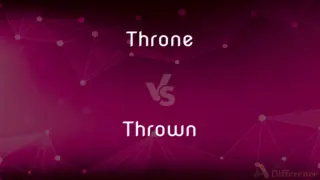Platypus vs. Puggle — What's the Difference?
Edited by Tayyaba Rehman — By Maham Liaqat — Updated on April 23, 2024
A platypus is a unique egg-laying mammal known for its duck-bill and webbed feet, while a puggle is the term for a baby platypus or echidna.

Difference Between Platypus and Puggle
Table of Contents
ADVERTISEMENT
Key Differences
The platypus is a distinct mammal native to eastern Australia, including Tasmania, famous for its unusual combination of features such as a duck-like bill, webbed feet, and the ability to lay eggs. In contrast, the term "puggle" refers specifically to the young of a platypus or an echidna, not yet fully developed and lacking the distinctive characteristics of the adults.
Adult platypuses are known for their aquatic habits and electrolocation abilities, which they use to find prey underwater. On the other hand, puggles are nurtured in burrows or pouches where they are protected and fed until they develop the capabilities to fend for themselves.
The diet of a platypus primarily consists of aquatic invertebrates, which they scoop up with their bill along muddy riverbeds. Puggles, however, feed solely on their mother's milk until they are old enough to leave the burrow and forage for their own food.
In terms of conservation status, the platypus is classified as a near-threatened species, facing threats from habitat loss and water pollution. The survival of puggles is crucial for the continuation of their species, making their protection in their vulnerable early stages vitally important.
Platypuses display unique breeding behaviors; they lay eggs which are incubated outside the body in specially constructed burrows. This contrasts with the early life of a puggle, which begins inside a leathery egg and continues in the safety of the mother's burrow or pouch, highlighting a significant phase in the reproductive cycle of these remarkable egg-laying mammals.
ADVERTISEMENT
Comparison Chart
Habitat
Eastern Australia, freshwater environments
Protected burrows or maternal pouches
Diet
Aquatic invertebrates
Mother’s milk
Physical Features
Duck-like bill, webbed feet
Lacks distinctive adult features initially
Conservation Status
Near-threatened
Dependent on species’ survival
Role in Lifecycle
Adult, capable of reproduction
Early life stage, dependent on maternal care
Compare with Definitions
Platypus
An egg-laying mammal with a bill and webbed feet.
The platypus uses its bill to detect prey underwater.
Puggle
The young of a platypus or echidna, not yet mature.
The puggle stays in the burrow, feeding on its mother's milk.
Platypus
Native to eastern Australia, unique among mammals.
The platypus is one of the few mammals that lays eggs.
Puggle
Dependent on the mother for nourishment and protection.
Puggles are vulnerable and rely heavily on maternal care.
Platypus
A semi-aquatic creature, it spends much of its time in water.
Platypuses are excellent swimmers and dive to find food.
Puggle
Lacks the adult features such as the bill and webbed feet initially.
Puggles gradually develop their distinctive features as they grow.
Platypus
Features electroreceptors to locate prey.
Electroreceptors in the platypus's bill help it find food in murky waters.
Puggle
Develops in a protective environment away from predators.
The mother platypus shields her puggle in a carefully dug burrow.
Platypus
Near-threatened species, requiring conservation efforts.
Conservationists are working to protect platypus habitats from pollution.
Puggle
Crucial for the continuation of their species.
The survival of each puggle is vital for the future of platypuses.
Platypus
The platypus (Ornithorhynchus anatinus), sometimes referred to as the duck-billed platypus, is a semiaquatic, egg-laying mammal endemic to eastern Australia, including Tasmania. The platypus is the sole living representative of its family (Ornithorhynchidae) and genus (Ornithorhynchus), though a number of related species appear in the fossil record.
Puggle
A puggle is a dog crossbred from a pug and a beagle.The puggle was first bred by designer dog breeders in the United States with the aim of producing a healthy companion dog that is less likely to inherit some health and behavioural issues common in the parent breeds. The cross is less likely to inherit a number of serious health issues common in the pug, particularly breathing issues associated with the breed's brachycephalic head, and is also less likely to inherit the energy, scent drive, and howl of the beagle; but due to the unpredictable nature of crossing two established breeds, puggles can still inherit both breathing disorders and high energy levels.Pugs and beagles were first deliberately crossed and marketed as companion dogs in the US in the 1980s, although designer dog breeders began breeding them in large numbers from the 1990s when the portmanteau "puggle" was first used to market the cross.
Platypus
A semiaquatic egg-laying mammal which frequents lakes and streams in eastern Australia. It has a sensitive pliable bill shaped like that of a duck, webbed feet with venomous spurs, and dense fur.
Puggle
To push or poke a stick or wire down (a hole or aperture) and work it about in order to clear an obstruction, drive out an animal, etc.
Platypus
A semiaquatic egg-laying mammal (Ornithorhynchus anatinus) of eastern Australia and Tasmania, having a broad flat tail, webbed feet, a snout resembling a duck's bill, and in the male, venomous spurs on the hind legs. Also called duckbill, duck-billed platypus.
Puggle
A baby echidna or platypus
After four weeks, the puggle starts to develop spines
The platypus keeper has now overseen the birth of five puggles at the zoo
Platypus
A semi-aquatic, egg-laying monotreme mammal with a bill resembling that of a duck, that has a mole-like body, a tail resembling that of a beaver, a waterproof pelt, and flat webbed feet — males have poisonous spurs on the inside of the back legs; Ornithorhynchus anatinus
Puggle
A dog that is a cross-breed of a pug and a beagle
He's a puggle, a beagle and pug mix, sporting a permanently frowny face
Platypus
The duck mole. See under Duck.
Puggle
A hybrid dog that is a cross between a pug and a beagle.
Platypus
Small densely furred aquatic monotreme of Australia and Tasmania having a broad bill and tail and webbed feet; only species in the family Ornithorhynchidae
Puggle
A young echidna or platypus.
Puggle
To coax (a rabbit) from a burrow by poking a stick down the hole and moving it about; to delve into a hole in order to locate an animal.
Puggle
To poke around a hole with a stick, as to explore, remove obstacles, etc.
Puggle
A baby monotreme (echidna or platypus).
Puggle
A small mixed breed of dog created by mating a pug and beagle.
Common Curiosities
What is a puggle?
A puggle is the term used for a baby platypus or baby echidna.
Are platypuses endangered?
Platypuses are considered near-threatened due to threats like habitat destruction and water pollution.
What is a platypus?
The platypus is a unique mammal known for its duck-like bill and ability to lay eggs, found in eastern Australia.
How does a platypus find its food?
Platypuses use electrolocation, detecting electric fields generated by the muscle contractions of their prey.
What measures are taken to protect platypuses in the wild?
Conservation efforts include monitoring populations, improving water quality, and protecting aquatic habitats.
Why is the platypus considered unique among mammals?
It is one of the few mammals that lays eggs and has unique features like a bill and webbed feet adapted for aquatic life.
Is there a specific season for platypuses to lay eggs?
Yes, platypuses typically lay eggs during the breeding season, which is between June and October.
How long does a puggle stay with its mother?
A puggle stays in the burrow feeding on its mother’s milk for several months before becoming independent.
What challenges do puggles face in the wild?
Puggles are vulnerable to predation and environmental changes, requiring protection during their early development.
How do puggles develop their distinctive features?
Puggles gradually develop features like the bill and webbing as they grow older.
Can puggles swim as soon as they are born?
No, puggles cannot swim until they are fully developed and leave the burrow.
How do platypuses reproduce?
Platypuses lay eggs in burrows, which the female incubates by curling around them.
Why are platypuses important to their ecosystem?
Platypuses help maintain the health of freshwater ecosystems by controlling the populations of aquatic invertebrates.
Share Your Discovery

Previous Comparison
Blackcurrant vs. Blackberry
Next Comparison
Throne vs. ThrownAuthor Spotlight
Written by
Maham LiaqatEdited by
Tayyaba RehmanTayyaba Rehman is a distinguished writer, currently serving as a primary contributor to askdifference.com. As a researcher in semantics and etymology, Tayyaba's passion for the complexity of languages and their distinctions has found a perfect home on the platform. Tayyaba delves into the intricacies of language, distinguishing between commonly confused words and phrases, thereby providing clarity for readers worldwide.















































